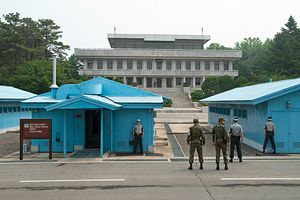According to Yonhap News Agency, even as other trusts face selling sprees from investors seeking to take advantage of the recent rallies in the stock market, capital is continuing to flood into South Korea’s two unification-tied funds. With their portfolios largely tied to companies operating in the inter-Korean industrial complex at Kaesong, the funds raised around $33.2 million between March 13 and May 23.
While market analysts rarely look kindly on funds that are highly vulnerable to unpredictable political developments and other external risks, an increasing number of investors are clearly anticipating changes in North Korea in the near-future. Park Sung-hyun, a strategist at Hanwha Investment and Securities Co., noted that he believes North Korea will seek a diplomatic breakthrough with South Korea soon, as Pyongyang’s dual strategy of developing nuclear weapons while pursuing economic growth (“Byongjin Line”) has clearly run aground.
Although Park did not set a timeline for when this breakthrough between the Koreas might occur, others were more forthcoming with their estimates. For instance, Jim Rogers, famous for co-founding the Quantum Fund with George Soros in 1973, noted that he believes unification may be possible in five years. Regardless of the exact timing, both Park and Rogers are united in their faith that the potential gains from the merger of South Korean capital and technology with North Korean natural resources and labor far outweigh the risks.
Perhaps more surprising than the exuberant optimism in the South Korean investment funds, is the rapid growth of foreign direct investment in North Korea. Dr. Bernhard Seliger, resident representative of Hanns Seidel Foundation in South Korea, visited North Korea earlier this month and observed signs of extensive Russian investment at Rason Special Economic Zone, a port located in northeastern North Korea close to the Russian border. Utilizing the rail line re-established last September between the Russian city of Khasan and Rason, freight trains were reportedly making roundtrips between the two countries twice a week, and four Russian-made container cranes (estimated at 1.9 million euro, or $2.6 million, each by Seliger) were spotted at the North Korean port.
With Moscow clearing nearly all of the debt owed by Pyongyang to Russia, and promising to increase the yearly trade between the two countries to $1 billion by 2020, Russia’s investments in North Korea are expected to grow. Paralleling Russia’s growing economic ties with North Korea, China has increased its trade with North Korea, and even Mongolia is establishing an economic presence at Rason. Underlying these economic investments, there is an implicit belief shared by all three countries that North Korea is headed toward greater regional integration in the near future.
But is this optimism grounded in any concrete signs of change in inter-Korean relations?
South Korean president Park Geun-hye’s remarks in her New Year’s Day address that unification will spur unprecedented prosperity, and her praise of German unification in March, may have bolstered the investment spirit. However, as Dr. Aiden Foster-Carter noted, Seoul is not well-positioned to jump start negotiations with Pyongyang because the Park administration has not yet signaled a coherent policy towards North Korea. This obscures Pyongyang’s ability to assess Seoul’s policy objectives and diminishes the trust necessary to initiate talks. In addition, as noted in a previous article, Seoul will be hard-pressed to lower sanctions against Pyongyang as long as North Korea continues to challenge the legitimacy of South Korea’s maritime border in the Yellow Sea, and refuses to accept culpability for the 2010 scuttling of the South Korean corvette Cheonan. This too will hinder both countries’ ability to establish the grounds for negotiations. At the same time, Pyongyang has taken no steps to forego its nuclear or ballistic weapons programs.
Thus while market optimism is an intriguing phenomenon, any actual move towards reconciliation between the two Koreas still appear far off.

































